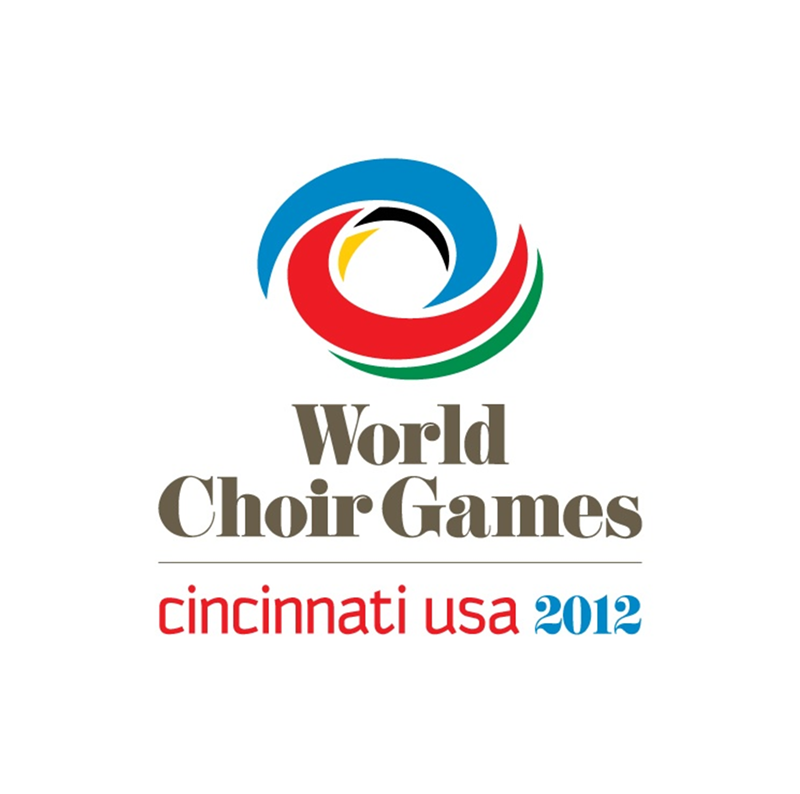I spent 12 hours on Thursday absorbing events and performances of the 2012 World Choir Games. My "day pass" gave me way too much to write up in detail, but here are some highlights and random observations.
Show Choirs: I spent several morning hours at the Aronoff Center (which was "sold-out" — no empty seats, before 10 a.m.!) watching groups perform in the manner popularized by the TV series Glee. Some followed the familiar model completely — glittering costumes, athletic dance numbers, lots of fist-pumping and high energy. They were fun to watch, but the international filter provided by groups from the Bahamas and Venezuela provided a whole new filter. The 26 members of the Bahama National Youth Choir dispensed with flashy costumes — young men and women wore khaki pants and skirts, topped with navy blue blazers and white shirts. But, boy, could they dance: From "It Don't Mean a Thing if it Ain't Got That Swing" to Michael Jackson's "Beat It." And when they finished (to a standing ovation), the next group, Orfeón Universitario Rafael Montaño from Puerto Ordaz, Venezuela, dazzled us with a salsa-inspired Spanish-language set with costume changes for every number — at one point including a dozen women with palm trees atop their heads! About half the numbers utilized wonderful soloists, mature women with incredible voices backed up by the choir in tributes to pop singers from the world of Hispanic music. The group's performance was a riot of color, dancing and joyous outbursts of energy.
Barbershop: This is a first-time category for WCG, a popular choir form in North America that's not practiced much elsewhere. But based on the big crowd for the competition at Music Hall, I'd say that singers of the world might be adopting this happy form of choral performance that involves close harmony, typically by groups that are all male or female. I smiled at a group of 32 from Minnesota, the North Star Boys Choir, and enjoyed the "mature" group of women, the Cincinnati Sound Chorus, who clearly enjoyed their set, opening with "As long as I'm singing my song." Three more choruses in colorful costumes — A Cappella Showcase (from Canada), Greater Harrisburg Sweet Adelines Chorus (from Pennsylvania) and Bay Area Showcase Chorus (from California) were all dazzlingly entertaining.
Friendship Concert: Departing from Music Hall late in the afternoon, I encountered a big crowd in Washington Park surrounding the bandstand. Patiently waiting for the moment to begin was a chorus of kids from Goteborg School in South Africa. The surrounding crowd was dotted with other performers, young African-American girls in maroon choir robes and pale girls from Russia in floaty pastel chiffon dresses with flowers in their hair, looking like escapees from a fantasy bridal party. I was tempted to pass by until the South African choir started to sing: They were elementary aged children who sang with lusty enthusiasm, and I couldn't tear myself away from listening to their rhythmic songs and high spirits. The crowd responded accordingly.
After dinner at Bakersfield on Vine Street, I went on to the day's real highlight, the Cultural Showcase at the Aronoff — another completely full house at the P&G Hall starting at 7:30 p.m. The Venezuelans I'd seen earlier in show choir mode were back doing a program of somewhat less flashy folk music numbers. There was still plenty of energy and costumes, as well as more work from the outstanding soloists. The next group was 65 boys from Kearsney College, a high school in Botha's Hill, South Africa. Half their program was sung in blue-and-white choir robes with a brilliant yellow icon of Africa on the front; this was a powerfully emotional set, full of the rhythms and zest that I've come to expect from South African ensembles. The second portion of their program focused on Zulu folklore and one of its heroes, King Shaka. For this portion the boys dressed in black shirts and pants with cardinal red belts and knee-high rubber boots, like those worn by miners. This set of music was non-stop athleticism, dancing, acrobatics and lusty singing. The audience responded warmly to this off-the-hook segment, and conductor Bernard Krüger told the audience that he loves Americans because they really know how to cheer. The final set of performers were from Istanbul, Turkey, the Bogaziçi Jazz Choir. This was a different kind of folk music from a country about which I don't know much, but watching their earnest, sometimes serious sometimes humorous delivery, I feel that I understand their character more fully. They concluded with several songs in English that warmed the audience even more — earning two standing ovations.
My final observation on the evening: It was so satisfying to be in an audience that truly loved what they were witnessing and expressed their joy at the performances with honest reactions. These were some of the most genuine standing ovations I've ever witnessed. I was proud to be in this crowd, and I have to believe that it was a truly memorable experience for the performers.
A final observation: Every choir I've heard from South Africa has deeply moved me. Knowing that nation's history of apartheid and seeing choirs of mixed races reveling in music gave me hope that music can indeed heal the world. That's a great lesson to learn from the World Choir Games.


